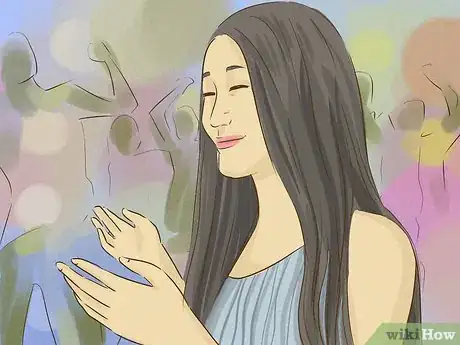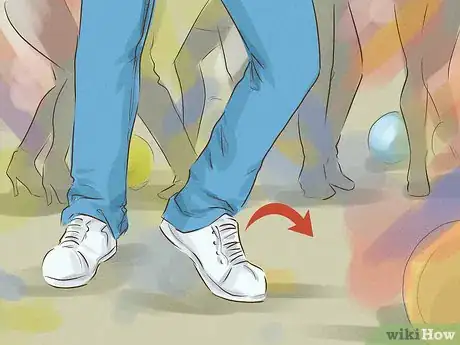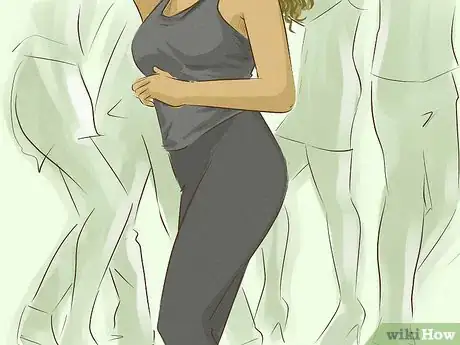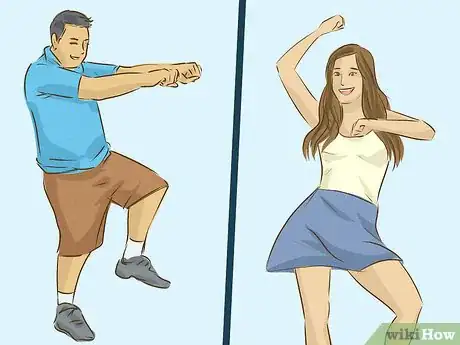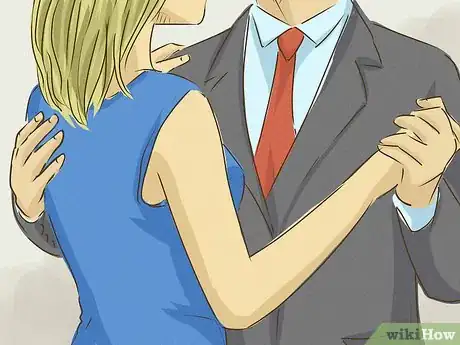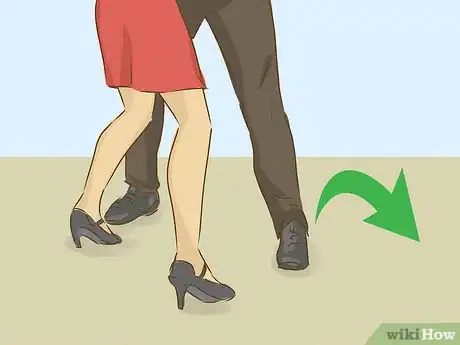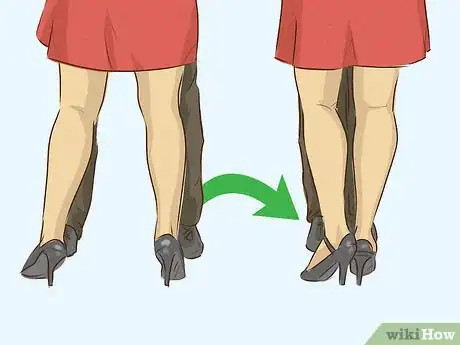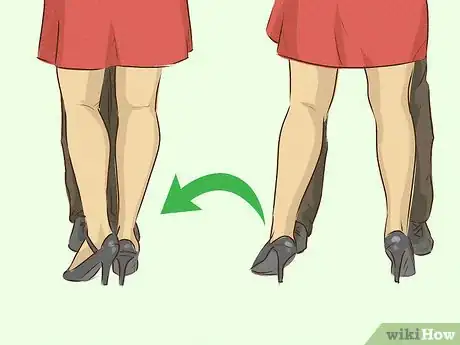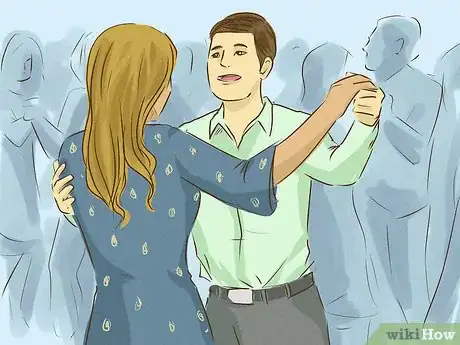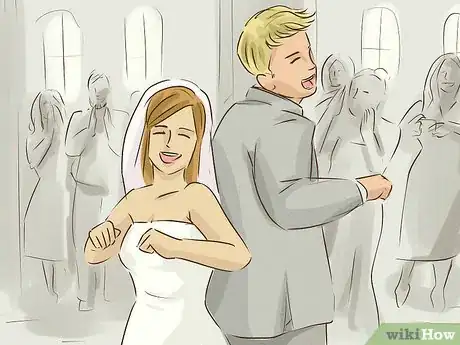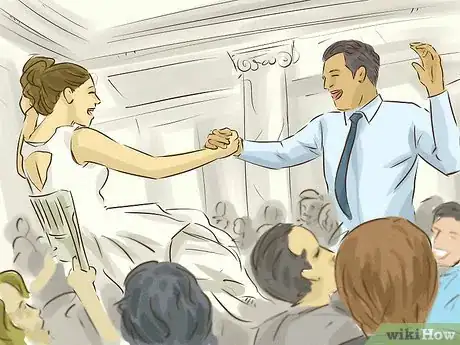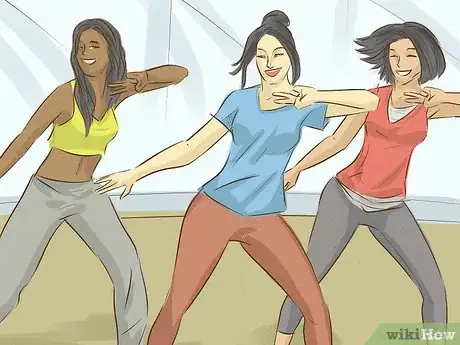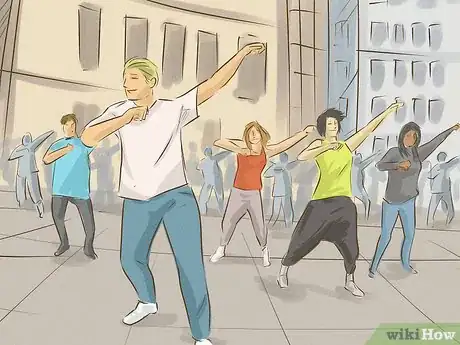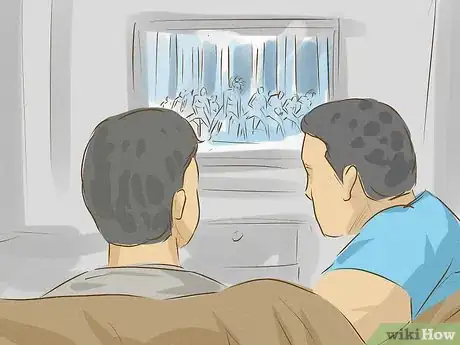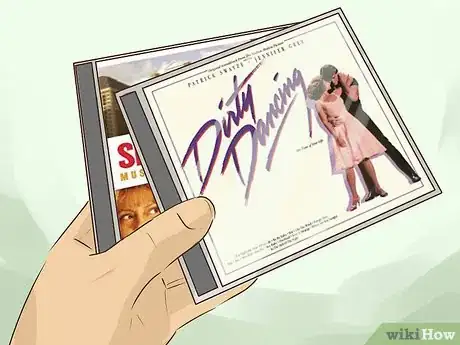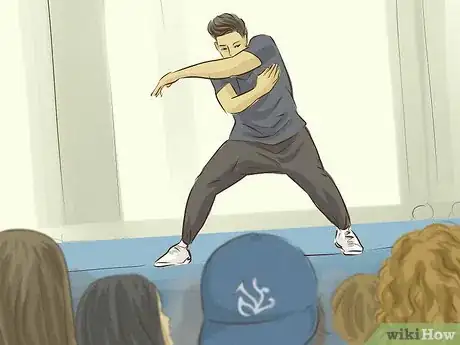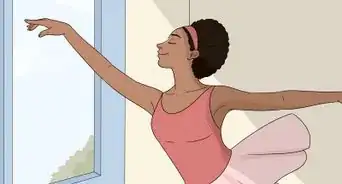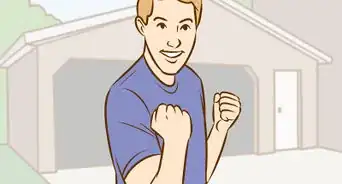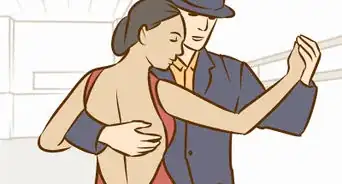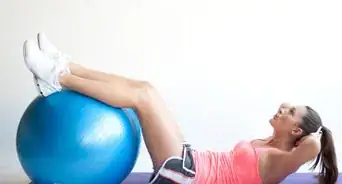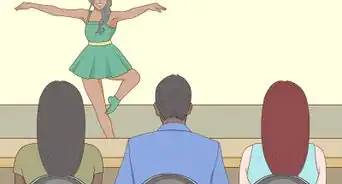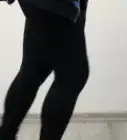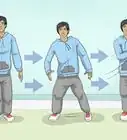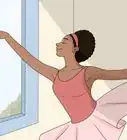This article was co-authored by Yolanda Thomas and by wikiHow staff writer, Megaera Lorenz, PhD. Yolanda Thomas is a Hip Hop Dance Instructor based in Los Angeles, California and Sydney, Australia. Yolanda has taught hip hop at the Sydney Dance Company and is a two-time winner of the LA Music Award for singing and songwriting. She has won Choreographer of the Year by GROOVE, an Australian hip hop dance competition and was hired by Google to choreograph their Sydney Mardi Gras float.
There are 22 references cited in this article, which can be found at the bottom of the page.
This article has been viewed 3,243,854 times.
Are you tired of standing in the corner of the room while everyone else is out on the dance floor? If so, you’re not alone—and we’ve got you covered! Dancing is a fun, mood-boosting activity that anyone can learn. Once you pick up a few basic moves, you can groove to any song and let the music guide your body. So, what are you waiting for? In this article, we’ll teach you some simple steps that you can whip out at any event, no matter your age or experience.
Things You Should Know
- To freestyle dance, bob your head to the beat and shift your weight from one foot to another.
- If you’re slow dancing with a partner, step to the left with your left foot, then slide your right foot over. Repeat this on the opposite side and let your partner mirror your moves.
- To learn some new dance moves, sign up for a local ballroom class or find inspiration online: watch movies, shows, or viral videos and try to recreate what you see.
Steps
Dancing Freestyle
-
1Bob your head to the rhythm. To find the beat of the music, listen to the drums or bass, which typically carry the rhythm of the song. Let the music guide your body and start bobbing your head however you like. If it helps, you can try counting along, snapping your fingers, or clapping your hands to the beat.[1]
- Once you get your head moving, you can also work the rest of your upper body—roll your shoulders back, pop your chest out, or sing the lyrics if you know the song.
- To get comfortable finding the rhythm of a song, listen to songs with a clear and pronounced beat. For example, you can try grooving to “Uptown Funk” by Mark Ronson (feat. Bruno Mars) or “Don’t Start Now” by Dua Lipa.
-
2Shift your weight from one foot to another. When you have a good sense of the beat, you can incorporate some simple footwork. Shift all of your weight to one foot, then lift the other foot slightly off the ground. At every other count, shift back and forth in time to the music.[2]
- You can also shift your weight at every count once you feel comfortable dancing at a faster pace.
- To look like a natural, keep your legs loose and your knees slightly bent. Add a bit of “bounce” every time you shift weight and a subtle bounce (in place) on the counts when you aren’t shifting weight.
Advertisement -
3Step-touch along with the beat. Once you're comfortable shifting your weight to the rhythm, you can take a bigger step. Right before you shift your weight to a foot, move it slightly, even just 1–2 inches (2.5–5.1 cm) from where it was before, and keep it fairly close to the ground when you move your foot.[3]
- Be sure to stay on the balls of your feet so you can move and bounce easily.
- If you're dancing with someone else, be sure to move around in a way that accommodates your partner.
-
4Add some hip action. When you put your weight on a foot, move your hips (and your body) slightly in the direction of that foot. If you shift your weight onto your right foot, for example, move your hips to the right. You can also twist your upper body slightly to add more movement and dimension.[4]
- For example, when you move to the right, put your right shoulder forward a little and your left shoulder back. Then, do the opposite when you move to the left.
-
5Incorporate some arm movements. To make your arms appear smooth and fluid, keep your hands open or in very loose fists. You can put your arms in the air or bend them at the elbows (like you’re running). But whatever you do, have fun and keep switching it up![5] If you don’t know where to start, try following one of these moves:
- Roll the dice. Make a loose fist and shake your arm and hand as though you’re shaking a pair of dice for a roll. After a few shakes, throw your hand out to "roll" the dice.
- Mow the lawn. Bend forward and grasp the starter of an imaginary lawn mower with one hand, then pull your hand back as though you're pulling on the starter. Once you get it going, take a few steps while you mow the lawn.
- Swing an air lasso. Grab an imaginary lasso and swing it above your head as though you're about to rope a cow. Shift your weight to the foot opposite your "lasso hand" and thrust your hips in that direction.
- Pump your fist. Get low and use your hand to hit the ground to the beat. As the song builds up, make a fist and pump it in the air in a celebratory fashion.[6]
-
6Find your own style. Follow your natural impulses when you’re dancing freestyle. It's easy to feel like you're only good at one move, but the more you feel the rhythm, the more natural your movements will become. Listening to subtleties in music will also help to train your body to move. Most importantly, be creative! Creating your own dance moves is easy with confidence and an understanding of your body.[7]
- Experiment with different moves, positions, and speeds while you dance.
- Don’t be afraid to make up your own moves. Free style is all about improvisation and individual expression.
- If you want to learn a particular dance style, focus on mastering one move first. For example, if you want to work on your dubstep dancing, practice body isolations or popping before imitating an entire routine.
Slow Dancing with a Partner
-
1Get into position with your partner. Stand face-to-face with your partner and get into a basic partner position. If you’re leading, put your right hand on your partner’s shoulder blade and interlock your left hand with their right hand, with your hands positioned in the shape of a pair of Cs. Instruct your partner to put their left hand on your right shoulder.[8]
- You can keep your clasped hands held as high as eye level or as low as waist level, depending on your preference. Just keep them relaxed, with a comfortable bend at the elbow, and don’t raise your partner’s shoulder.
- Leave about 3–6 inches (7.6–15.2 cm) of space between yourself and your partner.
- Make sure you and your partner agree on who is leading before you begin!
Tip: Although men traditionally lead in a slow dance, it doesn’t matter—have fun and pair up with any partner you like!
-
2Step to the left with your left foot. Once you’re ready to start dancing, move your left foot out to the side in a smooth, gliding motion. Let your partner mirror you with their right foot, as the first part of the basic “step-touch” slow dance move.[9]
- If your partner is leading, let them initiate the first step, but try to move with them as smoothly as possible.
- Try to time your steps with the beat of the music. You may find it helpful to count along with the music in your head.
-
3Bring your right foot over to meet your left. After taking the first step with your left foot, slide your right foot over so that it touches your left, and let your partner mirror this movement.[10]
- Try not to bounce or dip as you bring your feet together, and aim for a smooth, gliding movement.
-
4Repeat your foot movements in the opposite direction. Once you’ve brought your feet together, step to the right with your right foot. Then, bring your left foot over to meet your right. Continue this pattern throughout the rest of the dance.[11]
- Alternatively, you can do 2 steps to the left and then 2 steps to the right.
-
5Use your hands to steer your partner if you want to move around. To move around the dance floor, use your hands to gently push or pull your partner in the direction you want to go. After touching your feet together, push with one hand and pull with the other at the same time you step out on the next beat.[12]
- For example, if you’re stepping left but want to pivot to the right, start by bringing your right foot to meet your left. Then, push your partner’s right hand with your left hand while gently pulling on their shoulder with your right hand, and step to the left at the same time.
Dancing at a Wedding
-
1Learn the Chicken Dance for lighthearted numbers. The Chicken Dance is a staple of many wedding receptions—it's easy to do because there are just 3 basic moves, and you change them in time with the music. To perform this low-pressure routine:[13]
- Raise your arms to shoulder level and line your thumbs up with your index fingers to create a shape that resembles a chicken's beak. Move your thumbs up and down to simulate a chicken clucking.
- Then, ball up your hands and tuck your fists under your arms as though you have wings. Flap your wings up and down in time to the music.
- With your wings still in place, continue flapping but now stick out your backside, bend your knees and wiggle your bottom down toward the floor.
- Repeat these moves over and over until the song ends.
-
2Master the hora for Jewish weddings. The hora is danced at many traditional Jewish wedding receptions to the song "Hava Nagila" or other traditional Jewish songs. To follow the "grapevine" pattern: step the left foot across to the right (and let the right foot follow), then step the left foot behind the right and follow again with the right.[14]
- People usually position themselves in a circle, either holding hands or throwing their arms over one another's shoulders.
- The tempo of this dance is typically fast. Sometimes the music starts slowly, and the band speeds up the tempo as the song goes along.
Did you know? At Orthodox Jewish weddings, men and women dance the hora separately. At more liberal weddings, guests mingle and do the dance together.
-
3Use basic slow dance moves for the Dollar Dance. At some weddings, the guests line up and pay a dollar (or more) to dance with the wedding couple. You can perform a basic slow dance, but it's really not about the moves; it's about having a few moments with the merrier to express your happiness for the couple and compliment the wedding ceremony and reception.[15]
- Holding on and simply swaying in place is perfectly acceptable if it makes it easier to have a personal conversation.
Learning New Moves
-
1Take a dance class to pick up some basic moves. There are dance classes for every style of dancing from hip-hop to ballet, break dancing to salsa. Search online for the classes in your area, and don’t be afraid to ask your instructor for tips—they can help you overcome whatever it is you're finding to be difficult.
- When you are being taught a routine, look at what the teacher is doing. Try to copy it exactly. If it doesn't work, watch the teacher again and look for the little things they do that make it easier.
- Since many dance styles have their roots in ballroom dancing, consider learning the cha cha, waltz, or foxtrot.
- Even a few hours of class time can help you learn the basics and build your confidence.
-
2Learn a viral dance to add some moves to your arsenal. Whether it’s the renegade or the plug walk, participate in a TikTok dance challenge to master some moves in the privacy of your own home. Learn a dance quickly by searching for a tutorial on the app, or add the slow motion or inverted effect to someone else’s video. You can always incorporate the moves from a viral video the next time you hit the dance floor:
- Hit the griddy. Bend your knees slightly and tap the back of your heels, alternating between the left and right. You can do this in place or move forward, but be sure to add a little bounce to your step. Swing your arms back and forth, then throw up your Bs—make circles with your pointer finger and thumb and place them over your eyes like binoculars.[16]
- Get sturdy. Keep a little bounce to your step and alternate tapping your heels. After you feel comfortable, hop on your left leg and kick your right leg back and forth at the same time. Occasionally clap your hands under your right leg when you kick forward, then clap behind your back when you kick back.[17]
-
3Join a flash mob to boost your confidence. A flash mob is a spontaneous public performance—usually a dance—that appears seemingly out of nowhere and then disappears just as quickly. While these dance performances may seem spontaneous, the truth is that they're usually fairly well rehearsed in advance. You can find flash mobs online, join them for a several-week rehearsal period as the group learns a dance, and then perform with the mob in public.[18]
- Some flash mobs put videos online with instructions for learning and rehearsing the planned dance.
- Flash mobs welcome people of all skill levels; their focus is on having fun and creating a joyful scene, so the more people who participate, the better.
- You can also learn some great dance moves and connect with other people who enjoy dancing.
-
4Watch dancing on TV to find inspiration. Dancing is a wildly popular activity, and you can get plenty of exposure to it just by watching TV.[19] Since focusing on the steps might be a bit challenging, pay attention to how loose the dancers are, how much confidence they display, and how much fun it looks like they're having on the dance floor.
- Try tuning in to reality television dance competition shows like Dancing with the Stars, So You Think You Can Dance, or World of Dance.
-
5Rent a classic dance movie to get new ideas. Watching dance movies can help you add some moves to your repertoire. See as many as you can or pick and choose those that speak to your particular interests. For example:
- Check out Dirty Dancing or Shall We Dance to watch 2 dance novices develop confidence and grace and learn to perform with pizzazz.
- Watch Footloose or Flashdance to see the power of dance as a form of defiance against uptight authority figures and personal circumstances.
- Rent anything starring Fred Astaire and Ginger Rogers to be inspired by the grace and elegance of these famous dance partners.
- Watch Stormy Weather to see the Nicholas Brothers push the limits of tap dancing.
-
6Participate in a dance competition to hone your skills. Ballroom dancing competitions, officially known as DanceSport events, are held all over the world. Check online for a competition near you, and join a competition to help you set specific goals for yourself and encourage you to build your skills.[20]
- If you don’t know where to start, check out websites such as the International Grand Ball, United States Dance Championships, and the Access Dance Network.
Tip: If you’re not confident enough to join a competition yet, attending competitions as a spectator can help inspire you and give you an idea of what to expect.
What to Wear
-
1Put on comfortable dance shoes. Different styles of dance call for different types of shoes, so do some research about what’s needed for your preferred style. Choose a well-fitting shoe with a flexible, thin sole for the dance floor, and make sure you feel secure.[21]
- For example, sneakers are great for hip hop or freestyle dancing, while heels are ideal for Latin dance styles.
- Do not wear sneakers or other shoes with rubbery or sticky soles for ballroom style dancing, since these can make it hard to move your feet smoothly across the floor.
- Stay away from platform shoes, since that thick sole and heel make it difficult to feel the floor.
-
2Select sweat-resistant fabrics. If you tend to perspire, wear garments made of natural fibers like cotton, bamboo, or linen. These breathable fabrics draw moisture away from your skin, helping you cool down during your routine.[22]
- For extra sweat protection, drop a pack of moist towelettes and a travel-size powder in your pocket so you can freshen up when needed.
- If you’re dancing with a partner, avoid wearing slippery materials, like silk. Your partner may have a hard time holding onto you if their hands get sweaty.[23]
Tip: Consider bringing a spare top or a change of clothes in case you really work up a sweat.
-
3Wear clothes that allow you to move. While tight satin might look and feel great when you’re not moving much, it can inhibit your moves on the dance floor. Be sure to choose clothes that are either loose enough to let you move or stretchy enough to move with your body, and try on your outfit at home to be sure you can dance with ease. [24]
- Select a top with sleeves that don’t restrict your arm movement—you should be able to lift your arms above your head.
- To avoid wardrobe malfunctions, make sure your clothing fits securely and won’t slip out of place if you really get moving!
Expert Q&A
Did you know you can get premium answers for this article?
Unlock premium answers by supporting wikiHow
-
QuestionHow do you get good at dancing?
 Yolanda ThomasYolanda Thomas is a Hip Hop Dance Instructor based in Los Angeles, California and Sydney, Australia. Yolanda has taught hip hop at the Sydney Dance Company and is a two-time winner of the LA Music Award for singing and songwriting. She has won Choreographer of the Year by GROOVE, an Australian hip hop dance competition and was hired by Google to choreograph their Sydney Mardi Gras float.
Yolanda ThomasYolanda Thomas is a Hip Hop Dance Instructor based in Los Angeles, California and Sydney, Australia. Yolanda has taught hip hop at the Sydney Dance Company and is a two-time winner of the LA Music Award for singing and songwriting. She has won Choreographer of the Year by GROOVE, an Australian hip hop dance competition and was hired by Google to choreograph their Sydney Mardi Gras float.
Dance Coach Taking 3 or 4 dance lessons can be a great way to overcome your nerves and learn a few basic moves and techniques. Just make sure to check that the level of the class is suitable for you. Look for an Absolute Beginner or Basic Beginner course, but be aware that Open and Elementary classes are not beginner-level.
Taking 3 or 4 dance lessons can be a great way to overcome your nerves and learn a few basic moves and techniques. Just make sure to check that the level of the class is suitable for you. Look for an Absolute Beginner or Basic Beginner course, but be aware that Open and Elementary classes are not beginner-level. -
QuestionHow do you dance as a beginner?
 Yolanda ThomasYolanda Thomas is a Hip Hop Dance Instructor based in Los Angeles, California and Sydney, Australia. Yolanda has taught hip hop at the Sydney Dance Company and is a two-time winner of the LA Music Award for singing and songwriting. She has won Choreographer of the Year by GROOVE, an Australian hip hop dance competition and was hired by Google to choreograph their Sydney Mardi Gras float.
Yolanda ThomasYolanda Thomas is a Hip Hop Dance Instructor based in Los Angeles, California and Sydney, Australia. Yolanda has taught hip hop at the Sydney Dance Company and is a two-time winner of the LA Music Award for singing and songwriting. She has won Choreographer of the Year by GROOVE, an Australian hip hop dance competition and was hired by Google to choreograph their Sydney Mardi Gras float.
Dance Coach Having the right attitude will go a long way toward helping you learn to dance. If you want to learn to dance quickly, get rid of any negative talk and self doubt. When you see a certain dance step, don't tell yourself, "I can't do that." Instead, just try to copy it the best you can, even if you do it wrong.
Having the right attitude will go a long way toward helping you learn to dance. If you want to learn to dance quickly, get rid of any negative talk and self doubt. When you see a certain dance step, don't tell yourself, "I can't do that." Instead, just try to copy it the best you can, even if you do it wrong. -
QuestionI want to dance around the house and just in general (when music is playing), but I don't want to embarrass myself. I REALLY can't dance, and I always end up either hurting myself or someone else. Advice?
 wikiHow Staff EditorThis answer was written by one of our trained team of researchers who validated it for accuracy and comprehensiveness.
wikiHow Staff EditorThis answer was written by one of our trained team of researchers who validated it for accuracy and comprehensiveness.
Staff Answer wikiHow Staff EditorStaff AnswerPractice dancing alone at first, and dance in an area with plenty of open space so you have room to move without bumping into anything. If you tend to hurt yourself because of overexertion, do some light warmups (like dynamic stretches, lunges, kicks, or jumping jacks) before you start dancing. You might also benefit from some formal dance lessons to help build your confidence.
wikiHow Staff EditorStaff AnswerPractice dancing alone at first, and dance in an area with plenty of open space so you have room to move without bumping into anything. If you tend to hurt yourself because of overexertion, do some light warmups (like dynamic stretches, lunges, kicks, or jumping jacks) before you start dancing. You might also benefit from some formal dance lessons to help build your confidence.
Warnings
- Don't over-exert yourself or try any dance moves that you aren't comfortable with and haven't practiced extensively already. Good dancers make hard moves look easy—don't be fooled. You really can pull a muscle or trip and fall (especially if you're wearing heels).⧼thumbs_response⧽
References
- ↑ https://youtu.be/FsZF8PXtFaE?t=50
- ↑ https://youtu.be/m9ui75RptWg?t=29
- ↑ https://youtu.be/m9ui75RptWg?t=255
- ↑ https://youtu.be/W99uwIVCmc8?t=183
- ↑ https://youtu.be/G6xA8wbSCNM?t=30
- ↑ https://youtu.be/EDo00wi3r3Y?t=144
- ↑ https://youtu.be/KQdVOEF3XIo?t=14
- ↑ https://youtu.be/N6t0yjNBc84?t=19
- ↑ https://youtu.be/N6t0yjNBc84?t=48
- ↑ https://youtu.be/N6t0yjNBc84?t=60
- ↑ https://youtu.be/Jc1esMeDb5k?t=127
- ↑ https://youtu.be/Jc1esMeDb5k?t=141
- ↑ http://cguenter.yourweb.csuchico.edu/FourArts/DA/DAchick.html
- ↑ https://www.smashingtheglass.com/the-hora-everything-you-need-to-know/
- ↑ https://www.theknot.com/content/the-dollar-dance-wedding-etiquette-demystified-what-you-need-to-know-about-doing-one
- ↑ https://youtu.be/8lUv33mocaQ?t=18
- ↑ https://youtu.be/jnG2QwdO3IM?t=11
- ↑ https://wonderopolis.org/wonder/what-is-a-flash-mob
- ↑ http://www.cnn.com/2009/SHOWBIZ/TV/08/18/dance.shows.popular/index.html
- ↑ https://www.worlddancesport.org/WDSF
- ↑ https://personal.utdallas.edu/~aria/dance/etiquette.html#Comfort
- ↑ https://www.latangoacademy.com/blog/dance-floor-hygiene-dress-to-stay-fresh
- ↑ https://personal.utdallas.edu/~aria/dance/etiquette.html#Comfort
- ↑ https://personal.utdallas.edu/~aria/dance/etiquette.html#Comfort
About This Article
To dance, first listen for the beat of the music. The beat is usually carried by the drums and the bass. Most dance music is written with 4 beats per measure, with drum and bass elements repeating every 4 beats. Listen for these repetitions to find the beat. Once you find the beat, try the head nod by simply nodding your head to it. Next, practice swaying your upper body, and moving your arms slightly to the beat. After you're comfortable moving your upper body, add a basic step-touch with your feet. Every time you hear the beat, step one foot to the other, shifting most of your weight onto one foot. Keep your knees loose, and slightly bent while you find your rhythm. Continue by moving your feet back and forth to the beat to the music. Move your arms while you step in a way that feels natural. Whatever kind of dance you’re doing, focus on having fun instead of worrying about if your moves are perfect, since that’s what dancing is all about! For tips on learning other types of dancing, like slow dancing with a partner, read on!
